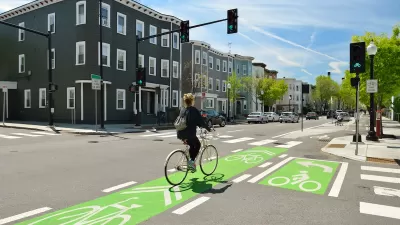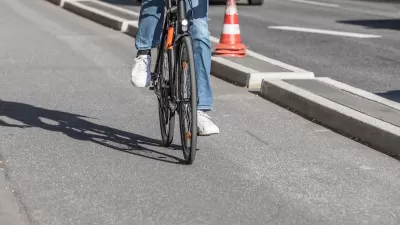The city’s complete streets manager answers questions about the city’s plans for improving its bike lane network.

In an interview with Courtney Kueppers of the Chicago Sun-Times, David Smith, complete streets manager at the Chicago Department of Transportation, answers questions about the city’s bike lane network. “Smith’s team at CDOT handles the bulk of the planning and design work around bike lanes, pedestrian improvements, transit projects and overall traffic safety,” Kueppers notes.
According to Smith, His department “started with a ground-up approach, identifying the places that people need to get to within the neighborhood and then from there worked with folks in the community to figure out which streets make the most sense to connect people to those places.” Answering a question about how the city is maintaining and improving existing bike infrastructure, Smith says, “We restriped existing bike lanes and things like the delineators [the flexible posts that cordon off some bike lanes] get replaced if those are damaged. We’re doing things on certain streets like ... installing [a] concrete curb to provide a bit more separation from people biking and people driving.”
Addressing concerns about the lack of east-west bike lanes in the city, Smith says “Our vision is to have a connected network across the entire city so you can go north, south, east, west. East-west there are some kind of unique barriers in the river and the expressway that provide some challenges and connectivity issues.” As far as the future goes, Smith is optimistic. “The number of low-stress routes, protected bike lanes plus neighborhood greenways is increasing dramatically. We’ve never done more than we are right now and that trend is going to continue.”
FULL STORY: How does the city decide where to put new bike lanes?

Alabama: Trump Terminates Settlements for Black Communities Harmed By Raw Sewage
Trump deemed the landmark civil rights agreement “illegal DEI and environmental justice policy.”

Study: Maui’s Plan to Convert Vacation Rentals to Long-Term Housing Could Cause Nearly $1 Billion Economic Loss
The plan would reduce visitor accommodation by 25% resulting in 1,900 jobs lost.

Planetizen Federal Action Tracker
A weekly monitor of how Trump’s orders and actions are impacting planners and planning in America.

Waymo Gets Permission to Map SF’s Market Street
If allowed to operate on the traffic-restricted street, Waymo’s autonomous taxis would have a leg up over ride-hailing competitors — and counter the city’s efforts to grow bike and pedestrian on the thoroughfare.

Parklet Symposium Highlights the Success of Shared Spaces
Parklets got a boost during the Covid-19 pandemic, when the concept was translated to outdoor dining programs that offered restaurants a lifeline during the shutdown.

Federal Homelessness Agency Places Entire Staff on Leave
The U.S. Interagency Council on Homelessness is the only federal agency dedicated to preventing and ending homelessness.
Urban Design for Planners 1: Software Tools
This six-course series explores essential urban design concepts using open source software and equips planners with the tools they need to participate fully in the urban design process.
Planning for Universal Design
Learn the tools for implementing Universal Design in planning regulations.
Caltrans
Smith Gee Studio
Institute for Housing and Urban Development Studies (IHS)
City of Grandview
Harvard GSD Executive Education
Toledo-Lucas County Plan Commissions
Salt Lake City
NYU Wagner Graduate School of Public Service





























